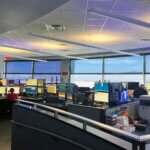When the mercury soars outside, the HVAC team at LAS ensures it’s cool inside. More than 35 professionals operate and maintain a variety of air cooling systems that keep passengers comfortable.
Digital controls allow virtual monitoring of cooling equipment, room temperatures and air flow to provide a pleasant indoor environment while keeping energy costs down.
“We have a building automation system and we’re able to access the entire airport and all the temperatures from just a few locations,” said Department of Aviation HVAC Planner Michael Galvin. “Instead of going to individual thermostats and responding to each location, we’re able to go to a computer station and find out which specific air handler or air conditioner is having the problem and then make adjustments. It saves the guys a lot of time and it’s better for energy management all around.”
Passenger loading bridges, or jet bridges, are among the most frequently used areas in the airport, and are constantly exposed to hot sunlight and outside temperature changes.
Jet bridges at Harry Reid are treated with a special coating on the exterior to reflect the heat and keep temperatures down on the inside.
“We put a ceramic coating on the jet bridges to help insulate them,” Galvin said. “And all of the jet bridges have recently gotten a brand new air conditioning unit which can cool the plane or the bridge.”
Areas in the airport that are prone to congestion, like the busy C Concourse and the D gates tram station, are equipped with high-volume, low-speed fans to help circulate the air and supplement the HVAC system.
“The fans keep the air moving a little better, instead of having the air handlers work harder,” Galvin said.
HVAC crews work in three shifts to monitor air handling equipment 24 hours a day, seven days a week. They train to gain knowledge about new technology, like that used in the new AC units installed on jet bridges. They also pass that knowledge along to the airlines, whose personnel operate the equipment.
“There’s something new every day and we just try to stay ahead of it, to plan so next summer is better, or this summer is better than last summer … to keep our airport employees and our guests happy,” Galvin said.
Jet Bridge
Passenger boarding bridges are treated with a ceramic coating to reflect the heat. Each bridge is equipped with its own air conditioning unit, which can cool both the bridge and the plane.
Central Plant
Cooling towers at the airport’s Central Plants are part of a process designed to keep passengers cool. The towers remove heat from the building through miles of chilled water and piping, transferring the heat outside.








